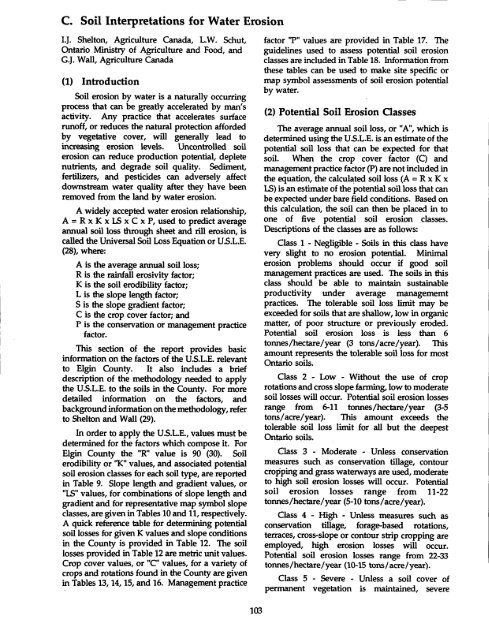The Soils of Elgin County - Agriculture and Agri-Food Canada
The Soils of Elgin County - Agriculture and Agri-Food Canada
The Soils of Elgin County - Agriculture and Agri-Food Canada
- No tags were found...
Create successful ePaper yourself
Turn your PDF publications into a flip-book with our unique Google optimized e-Paper software.
C .Soil Interpretations for Water ErosionI.J. Shelton, <strong><strong>Agri</strong>culture</strong> <strong>Canada</strong>, L.W. Schut,Ontario Ministry <strong>of</strong> <strong><strong>Agri</strong>culture</strong> <strong>and</strong> <strong>Food</strong>, <strong>and</strong>G.J. Wall, <strong><strong>Agri</strong>culture</strong> <strong>Canada</strong>(1) IntroductionSoil erosion by water is a naturally occurringprocess that can be greatly accelerated by man'sactivity. Any practice that accelerates surfacerun<strong>of</strong>f, or reduces the natural protection affordedby vegetative cover, will generally lead toincreasing erosion levels . Uncontrolled soilerosion can reduce production potential, depletenutrients, <strong>and</strong> degrade soil quality . Sediment,fertilizers, <strong>and</strong> pesticides can adversely affectdownstream water quality after they have beenremoved from the l<strong>and</strong> by water erosion .A widely accepted water erosion relationship,A = R x K x ILS x C x P, used to predict averageannual soil loss through sheet <strong>and</strong> rill erosion, iscalled the Universal Soil Loss Equation or US.L .E .(28), where:A is the average annual soil loss;R is the rainfall erosivity factor;K is the soil erodibility factor;L is the slope length factor;S is the slope gradient factor,C is the crop cover factor; <strong>and</strong>P is the conservation or management practicefactor .This section <strong>of</strong> the report provides basicinformation on the factors <strong>of</strong> the U.S.L.E. relevantto <strong>Elgin</strong> <strong>County</strong>. It also includes a briefdescription <strong>of</strong> the methodology needed to applythe U.S.L .E. to the soils in the <strong>County</strong>. For moredetailed information on the factors, <strong>and</strong>background informationon the methodology, referto Shelton <strong>and</strong> Wall (29) .In order to apply the U.S.L .E., values must bedetermined for the factors which compose it . For<strong>Elgin</strong> <strong>County</strong> the "R" value is 90 (30) . Soilerodibility or 'IC" values, <strong>and</strong> associated potentialsoil erosion classes for each soil type, are reportedin Table 9 . Slope length <strong>and</strong> gradient values, or"LS" values, for combinations <strong>of</strong> slope length <strong>and</strong>gradient <strong>and</strong> for representative map symbol slopeclasses, are given in Tables 10 <strong>and</strong> 11, respectively.A quick reference table for determining potentialsoil losses for given K values <strong>and</strong> slope conditionsin the <strong>County</strong> is provided in Table 12 . <strong>The</strong> soillosses provided in Table 12 are metric unit values.Crop cover values, or "C" values, for a variety <strong>of</strong>crops <strong>and</strong> rotations found in the <strong>County</strong> are givenin Tables 13, 14, 15, <strong>and</strong> 16. Management practicefactor 'P" values are provided in Table 17. <strong>The</strong>guidelines used to assess potential soil erosionclasses are included in Table 18 . Information fromthese tables can be used to make site specific ormap symbol assessments <strong>of</strong> soil erosion potentialby water.(2) Potential Soil Erosion Classes<strong>The</strong> average annual soil loss, or "A", which isdetermined using the US .L .E. is an estimate <strong>of</strong> thepotential soil loss that can be expected for thatsoil . When the crop cover factor (C) <strong>and</strong>management practice factor (P) are not included inthe equation, the calculated soil loss (A = R x K xLS) is an estimate <strong>of</strong> the potential soil loss that canbe expected under bare field conditions. Based onthis calculation, the soil can then be placed in toone <strong>of</strong> five potential soil erosion classes .Descriptions <strong>of</strong> the classes are as follows:Class 1 - Negligible - <strong>Soils</strong> in this class havevery slight to no erosion potential . Minimalerosion problems should occur if good soilmanagement practices are used . <strong>The</strong> soils in thisclass should be able to maintain sustainableproductivity under average managementpractices . <strong>The</strong> tolerable soil loss limit may beexceeded for soils that are shallow, low in organicmatter, <strong>of</strong> poor structure or previously eroded .Potential soil erosion loss is less than 6tonnes/hectare/year (3 tons/acre/year) . Thisamount represents the tolerable soil loss for mostOntario soils.Class 2 - Low - Without the use <strong>of</strong> croprotations <strong>and</strong> cross slope farming, low to moderatesoil losses will occur. Potential soil erosion lossesrange from 6-11 tonnes/hectare/year (3-5tons/acre/year) . This amount exceeds thetolerable soil loss limit for all but the deepestOntario soils.Class 3 - Moderate - Unless conservationmeasures such as conservation tillage, contourcropping <strong>and</strong> grass waterways are used, moderateto high soil erosion losses will occur. Potentialsoil erosion losses range from 11-22tonnes/hectare/year (5-10 tons/acre/year).Class 4 - High - Unless measures such asconservation tillage, forage-based rotations,terraces, cross-slope or contour strip cropping areemployed, high erosion losses will occur.Potential soil erosion losses range from 22-33tonnes/hectare/year (10-15 tons/acre/year) .Class 5 - Severe - Unless a soil cover <strong>of</strong>permanent vegetation is maintained, severe103
















